Java
I used an approach based on recursive Voronoi diagrams. The outputs doesn't look very realistic, but I guess they're okay.
Here are some example images (resized to 250x250 so that it doesn't fill the entire screen):
0:
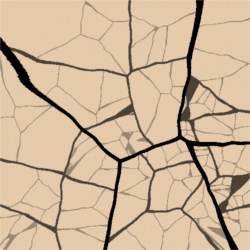
1:
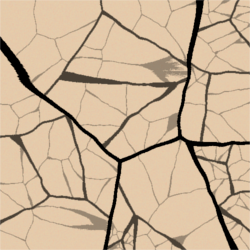
More details about the algorithm:
All images in this section are using the same seed.
The algorithm starts by generating a Voronoi diagram with 5 points:

If we look at the original images in the challenge, we can see that the lines aren't all straight like that, so we weigh the distance by a random value, based on the angle to the point, also, closer angles gives closer values:
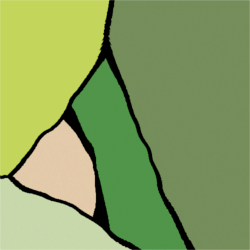
Now, we recursively draw these kinds of Voronoi diagrams inside of each region, with thinner and more transparent line, and remove the background, with a maximum recursion depth of 3, and we get:
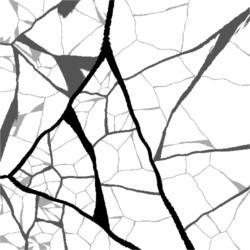
Now, we just add the pale brown background, and we're done!
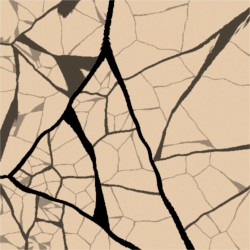
Code:
The code consists of three classes, Main.java, VoronoiPoint.java and Vector.java:
Main.java:
import java.awt.Desktop;
import java.awt.Graphics;
import java.awt.image.BufferedImage;
import java.io.File;
import java.io.IOException;
import java.util.ArrayList;
import java.util.Arrays;
import java.util.HashMap;
import java.util.Random;
import javax.imageio.ImageIO;
public class Main {
public static int WIDTH = 500;
public static int HEIGHT = 500;
public static int RECURSION_LEVELS = 3;
public static int AMOUNT_OF_POINTS = 5;
public static int ROTATION_RESOLUTION = 600;
public static int ROTATION_SMOOTHNESS = 10;
public static int BACKGROUND = 0xFFE0CBAD;
public static Random RAND;
public static void main(String[] args) {
int seed = new Random().nextInt(65536);
if (args.length == 1) {
System.out.println(Arrays.toString(args));
seed = Integer.parseInt(args[0]);
} else {
System.out.println("Generated seed: " + seed);
}
RAND = new Random(seed);
ArrayList<Vector> points = new ArrayList<Vector>();
for (int x = 0; x < WIDTH; x++) {
for (int y = 0; y < HEIGHT; y++) {
points.add(new Vector(x, y));
}
}
BufferedImage soil = generateSoil(WIDTH, HEIGHT, seed, points, AMOUNT_OF_POINTS, RECURSION_LEVELS);
BufferedImage background = new BufferedImage(WIDTH, HEIGHT, BufferedImage.TYPE_INT_ARGB);
for (int x = 0; x < background.getWidth(); x++) {
for (int y = 0; y < background.getHeight(); y++) {
background.setRGB(x, y, BACKGROUND ^ (RAND.nextInt(10) * 0x010101));
}
}
Graphics g = background.getGraphics();
g.drawImage(soil, 0, 0, null);
g.dispose();
String fileName = "soil";
File output = new File(fileName + ".png");
for (int i = 0; output.exists(); i++) {
output = new File(fileName + i + ".png");
}
try {
ImageIO.write(background, "png", output);
Desktop.getDesktop().open(output);
} catch (IOException e) {
e.printStackTrace();
}
System.out.println("Done. Saved as " + output);
}
private static BufferedImage generateSoil(int width, int height, int seed, ArrayList<Vector> drawPoints,
int amountOfPoints, int recursionLevel) {
BufferedImage result = new BufferedImage(width, height, BufferedImage.TYPE_INT_ARGB);
ArrayList<VoronoiPoint> points = new ArrayList<VoronoiPoint>();
for (int i = 0; i < amountOfPoints; i++) {
points.add(new VoronoiPoint(drawPoints.get(RAND.nextInt(drawPoints.size()))));
}
HashMap<Integer, ArrayList<Vector>> pointMaps = new HashMap<Integer, ArrayList<Vector>>();
for (VoronoiPoint point : points) {
pointMaps.put(point.hashCode(), new ArrayList<Vector>());
}
System.out.println(pointMaps);
System.out.println(points);
for (Vector v : drawPoints) {
VoronoiPoint closest = null;
VoronoiPoint secondClosest = null;
for (VoronoiPoint point : points) {
double distance = point.getMultiplicativeDistanceTo(v);
if (closest == null || distance < closest.getMultiplicativeDistanceTo(v)) {
secondClosest = closest;
closest = point;
} else if (secondClosest == null || distance < secondClosest.getMultiplicativeDistanceTo(v)) {
secondClosest = point;
}
}
int col = 0;
if (Math.abs(closest.getMultiplicativeDistanceTo(v)
- secondClosest.getMultiplicativeDistanceTo(v)) < (recursionLevel * 5 / RECURSION_LEVELS)) {
col = 0x01000000 * (recursionLevel * 255 / RECURSION_LEVELS);
} else {
pointMaps.get(closest.hashCode()).add(v);
}
result.setRGB((int) v.getX(), (int) v.getY(), col);
}
Graphics g = result.getGraphics();
if (recursionLevel > 0) {
for (ArrayList<Vector> pixels : pointMaps.values()) {
if (pixels.size() > 10) {
BufferedImage img = generateSoil(width, height, seed, pixels, amountOfPoints,
recursionLevel - 1);
g.drawImage(img, 0, 0, null);
}
}
}
g.dispose();
return result;
}
public static int modInts(int a, int b) {
return (int) mod(a, b);
}
public static double mod(double a, double b) {
a = a % b;
while (a < 0)
a += b;
return a;
}
}
VoronoiPoint.java:
public class VoronoiPoint {
private Vector pos;
private double[] distances;
public VoronoiPoint(Vector pos) {
this.pos = pos;
distances = new double[Main.ROTATION_RESOLUTION];
for (int i = 0; i < distances.length; i++)
distances[i] = Main.RAND.nextFloat() / 2 + 0.51;
for (int iter = 0; iter < Main.ROTATION_SMOOTHNESS; iter++) {
for (int i = 0; i < distances.length; i++) {
distances[i] = (distances[Main.modInts(i - Main.RAND.nextInt(4) - 2, distances.length)] + distances[i]
+ distances[Main.modInts(i + Main.RAND.nextInt(4) - 2, distances.length)]) / 3;
}
}
}
public Vector getPos() {
return pos;
}
public double getRotationFromAngle(double radians) {
return distances[(int) (Main.mod(Math.toDegrees(radians) / 360, 1) * distances.length)];
}
public double getRotationFromVector(Vector vec) {
return getRotationFromAngle(Math.atan2(pos.getY() - vec.getY(), -(pos.getX() - vec.getX())));
}
public double getMultiplicativeDistanceTo(Vector other) {
return pos.getLengthTo(other) * getRotationFromVector(other);
}
public String toString() {
return "VoronoiPoint(pos=[" + pos.getX() + ", " + pos.getY() + "])";
}
public int hashCode() {
return distances.hashCode() ^ pos.hashCode();
}
}
Vector.java: (This class is copied from one of my other projects, so it contains some unnecessary code)
package com.loovjo.soil;
import java.util.ArrayList;
import java.util.Random;
public class Vector {
private static final float SMALL = 1f / Float.MAX_EXPONENT * 100;
private float x, y;
public Vector(float x, float y) {
this.setX(x);
this.setY(y);
}
public Vector(int x, int y) {
this.setX(x);
this.setY(y);
}
public Vector(double x, double y) {
this.setX((float) x);
this.setY((float) y);
}
public float getY() {
return y;
}
public void setY(float y) {
this.y = y;
}
public float getX() {
return x;
}
public void setX(float x) {
this.x = x;
}
/*
* Gets the length ^ 2 This is faster than getting the length.
*/
public float getLengthToSqrd(float x, float y) {
return (float) ((this.x - x) * (this.x - x) + (this.y - y) * (this.y - y));
}
public float getLengthToSqrd(Vector v) {
return getLengthToSqrd(v.x, v.y);
}
public float getLengthSqrd() {
return getLengthToSqrd(0, 0);
}
public float getLengthTo(float x, float y) {
return (float) Math.sqrt(getLengthToSqrd(x, y));
}
public float getLengthTo(Vector v) {
return getLengthTo(v.x, v.y);
}
public float getLength() {
return getLengthTo(0, 0);
}
public Vector setLength(float setLength) {
float length = getLength();
x *= setLength / length;
y *= setLength / length;
return this;
}
public float getFastLengthTo(float x, float y) {
return getFastLengthTo(new Vector(x, y));
}
public float getFastLengthTo(Vector v) {
float taxiLength = getTaxiCabLengthTo(v);
float chebyDist = getChebyshevDistanceTo(v);
return Float.min(taxiLength * 0.7f, chebyDist);
}
public float getFastLength() {
return getLengthTo(0, 0);
}
public Vector setFastLength(float setLength) {
float length = getFastLength();
x *= setLength / length;
y *= setLength / length;
return this;
}
public float getTaxiCabLengthTo(float x, float y) {
return Math.abs(this.x - x) + Math.abs(this.y - y);
}
public float getTaxiCabLengthTo(Vector v) {
return getTaxiCabLengthTo(v.x, v.y);
}
public float getTaxiCabLength() {
return getTaxiCabLengthTo(0, 0);
}
public Vector setTaxiCabLength(float setLength) {
float length = getTaxiCabLength();
x *= setLength / length;
y *= setLength / length;
return this;
}
public Vector absIfBoth() {
if (x < 0 && y < 0)
return new Vector(-x, -y);
return this;
}
public Vector abs() {
return new Vector(x < 0 ? -x : x, y < 0 ? -y : y);
}
public float getChebyshevDistanceTo(float x, float y) {
return Math.max(Math.abs(this.x - x), Math.abs(this.y - y));
}
public float getChebyshevDistanceTo(Vector v) {
return getChebyshevDistanceTo(v.x, v.y);
}
public float getChebyshevDistance() {
return getChebyshevDistanceTo(0, 0);
}
public Vector setChebyshevLength(float setLength) {
float length = getChebyshevDistance();
x *= setLength / length;
y *= setLength / length;
return this;
}
public Vector sub(Vector v) {
return new Vector(this.x - v.getX(), this.y - v.getY());
}
public Vector add(Vector v) {
return new Vector(this.x + v.getX(), this.y + v.getY());
}
public Vector mul(Vector v) {
return new Vector(this.x * v.getX(), this.y * v.getY());
}
public Vector mul(float f) {
return mul(new Vector(f, f));
}
public Vector div(Vector v) {
return new Vector(this.x / v.getX(), this.y / v.getY());
}
public Vector div(float f) {
return div(new Vector(f, f));
}
public Vector mod(Vector v) {
return new Vector(this.x % v.getX(), this.y % v.getY());
}
public Vector mod(int a, int b) {
return mod(new Vector(a, b));
}
public Vector mod(int a) {
return mod(a, a);
}
public String toString() {
return "Vector(" + getX() + ", " + getY() + ")";
}
/*
* Returns a list with vectors, starting with this, ending with to, and each
* one having length between them
*/
public ArrayList<Vector> loop(Vector to, float length) {
Vector delta = this.sub(to);
float l = delta.getLength();
ArrayList<Vector> loops = new ArrayList<Vector>();
for (float i = length; i < l; i += length) {
delta.setLength(i);
loops.add(delta.add(to));
}
loops.add(this);
return loops;
}
public boolean intersects(Vector pos, Vector size) {
pos.sub(this);
if (pos.getX() < getX())
return false;
if (pos.getY() < getY())
return false;
return true;
}
public Vector copy() {
return new Vector(x, y);
}
public void distort(float d) {
x += Math.random() * d - d / 2;
y += Math.random() * d - d / 2;
}
@Override
public boolean equals(Object o) {
if (o instanceof Vector) {
Vector v = (Vector) o;
return getLengthToSquared(v) < SMALL * SMALL;
}
return false;
}
private float getLengthToSquared(Vector v) {
return sub(v).getLengthSquared();
}
private float getLengthSquared() {
return x * x + y * y;
}
public boolean kindaEquals(Vector o, int i) {
if (o.x + i < x)
return false;
if (o.x - i > x)
return false;
if (o.y + i < y)
return false;
if (o.y - i > y)
return false;
return true;
}
/*
* Gets the direction, from 0 to 8.
*/
public int getDirection() {
return (getDirectionInDegrees()) / (360 / 8);
}
/*
* Gets the direction in degrees.
*/
public int getDirectionInDegrees() {
return (int) positize((float) Math.toDegrees(Math.atan2(x, -y)), 360f);
}
private float positize(float f, float base) {
while (f < 0)
f += base;
return f;
}
// 0 = north,
// 1 = northeast,
// 2 = east,
// 3 = southeast,
// 4 = south,
// 5 = southwest,
// 6 = west,
// 7 = northwest
public Vector moveInDir(int d) {
d = d % 8;
d = (int) positize(d, 8);
if (d == 0)
return this.add(new Vector(0, -1));
if (d == 1)
return this.add(new Vector(1, -1));
if (d == 2)
return this.add(new Vector(1, 0));
if (d == 3)
return this.add(new Vector(1, 1));
if (d == 4)
return this.add(new Vector(0, 1));
if (d == 5)
return this.add(new Vector(-1, 1));
if (d == 6)
return this.add(new Vector(-1, 0));
if (d == 7)
return this.add(new Vector(-1, -1));
return this;
}
/*
* Gets the angle in degrees to o.
*/
public float getRotationTo(Vector o) {
float d = (float) Math.toDegrees((Math.atan2(y - o.y, -(x - o.x))));
while (d < 0)
d += 360;
while (d > 360)
d -= 360;
return d;
}
public float getRotation() {
return getRotationTo(new Vector(0, 0));
}
/*
* In degrees
*/
public Vector rotate(double n) {
n = Math.toRadians(n);
float rx = (float) ((this.x * Math.cos(n)) - (this.y * Math.sin(n)));
float ry = (float) ((this.x * Math.sin(n)) + (this.y * Math.cos(n)));
return new Vector(rx, ry);
}
public int hashCode() {
int xx = (int) x ^ (int)(x * Integer.MAX_VALUE);
int yy = (int) y ^ (int)(y * Integer.MAX_VALUE);
return new Random(12665 * xx).nextInt() ^ new Random(5349 * yy).nextInt() + new Random((30513 * xx) ^ (19972 * yy)).nextInt();
}
public boolean isPositive() {
return x >= 0 && y >= 0;
}
public Vector clone() {
return new Vector(x, y);
}
}
But I don't want to compile a bunch of Java classes!
Here is a JAR file which you can run to generate these images yourself. Run as java -jar Soil.jar number, where number is the seed (can be anything up to 231-1), or run as java -jar Soil.jar, and it chooses a seed by itself. There will be some debug output.















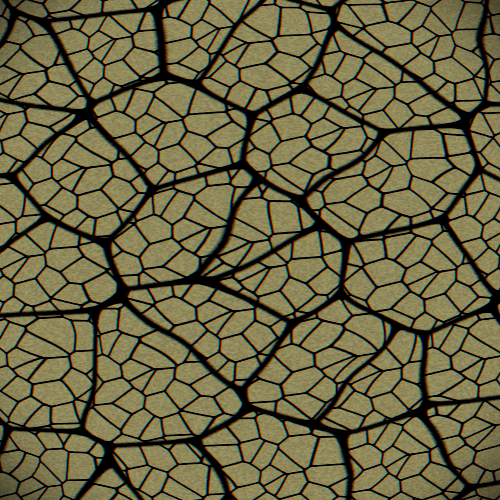

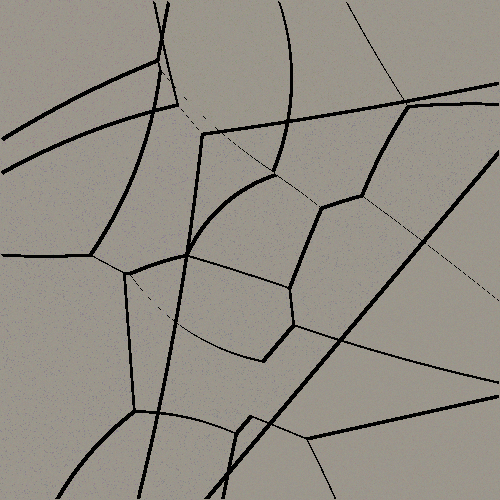


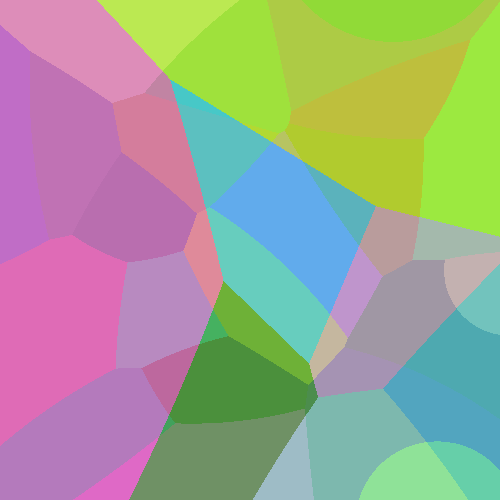

You might want to clarify to make photorealistic objective. – Leaky Nun – 2016-06-16T20:05:42.527
How do you come up with so many ideas for challenges? I can only think of 1/month or so. – NoOneIsHere – 2016-06-16T20:09:04.300
@NoOneIsHere This particular challenge genre is easy to come up with ideas for. Instead of a cracked soil texture you could do wood grain or gravel or grass or oriented strand board. (Though their reception on this site might be variable.) – Calvin's Hobbies – 2016-06-16T20:15:03.383
6
I've voted to close this challenge as Too Broad because it lacks objective validity criteria.
– AdmBorkBork – 2016-06-16T20:35:48.8101
@TimmyD Note that this challenge is very similar to my previous challenge Computer Generated Textured Wall Paint, which was received quite well.
– Calvin's Hobbies – 2016-06-16T20:38:59.7101@HelkaHomba We've discussed this thoroughly and also added this as a rule in the tag description of [tag:popularity-contest]. So please add an explicit objective validity criterion. – flawr – 2016-06-16T20:40:09.520
PS: I actually think this is a great challenge idea, but it might have benefitted from a while in the sandbox! – flawr – 2016-06-16T20:47:18.000
4@HelkaHomba Whether an old challenge was well-received or not shouldn't have bearing on whether a challenge now fits with the rules of the site as decided by consensus. PopCons have had tremendous discussion over the past months, one of the results was that all PopCons need an objective validity criterion. This challenge doesn't have that. Thus, it's too broad. – AdmBorkBork – 2016-06-16T20:48:29.627
15
The current rules about pop cons are so dumb that I'd take this chance to ignore them and see how it works out. This topic has been brought up on meta where it's discussed to death but nothing actually changes, so I think the best chance at something happening is to keep some pop cons and see how they do.
– xnor – 2016-06-16T21:05:45.6636The objective validity criteria here are "unique" (distinct from the other 65535) and "500x500 pixel". The resemblance to the example images cannot be objectively defined, or this wouldn't be a popularity contest but a code challenge. – trichoplax – 2016-06-16T21:05:57.327
2Resemblance to a single target image can be defined in a variety of ways, meaning that popularity contest is not necessarily the only possible winning criterion. However, for an array of example images, where the objective is realism rather than replication, it makes most sense to use human judgment as the winning criterion. – trichoplax – 2016-06-16T21:10:22.770
14I see bad pop cons like "make something pretty" with no restriction, and good pop cons like "match this specification" with humans voting on which matches best. I definitely see this challenge as the good kind. – trichoplax – 2016-06-16T21:12:35.140
I don't get it. What's the point of taking an input? – James – 2016-06-16T22:48:16.473
4@DrGreenEggsandIronMan So the output is repeatable - deterministic but varied. – Calvin's Hobbies – 2016-06-16T22:50:50.207
I can already tell, I need a seeded voronoi diagram for this. – Bálint – 2016-06-17T02:44:45.107
2 actually, 1 for the larger gaps abd 1 for the smaller ones – Bálint – 2016-06-17T02:46:27.897
@xnor, the last unclosed popcon before this one was 5 months ago. Although they were originally allowed to stay in contravention of the site norms as a measure to help it get off the ground, it's clear that the site no longer needs to make exceptions in order to survive, so I think that explicitly encouraging people to turn a blind eye to the norms is unhelpful. – Peter Taylor – 2016-06-17T07:54:27.877
@Bálint Look closer - there are smaller cracks again... – trichoplax – 2016-06-17T13:55:34.187
@PeterTaylor dumb rules do not help either – edc65 – 2016-06-21T12:43:26.497
Shouldn't you combine code-challenge with popularity-contest? – None – 2016-07-25T09:07:06.613